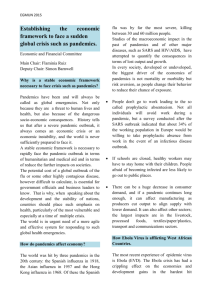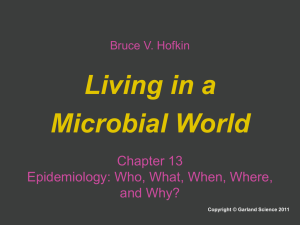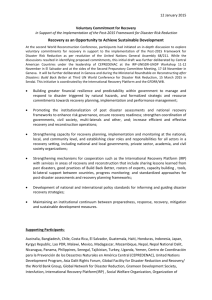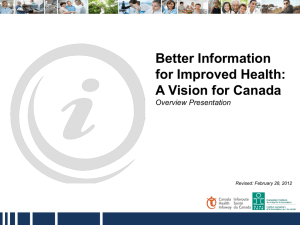Reducing Risks of Epidemics and Pandemics
advertisement
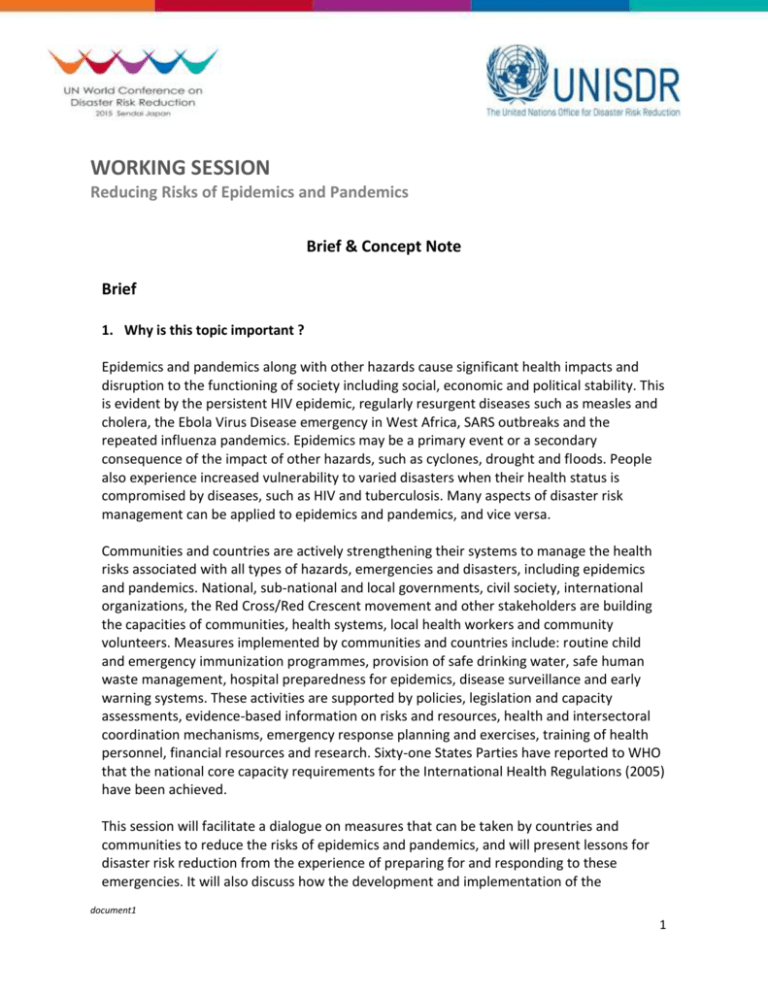
WORKING SESSION Reducing Risks of Epidemics and Pandemics Brief & Concept Note Brief 1. Why is this topic important ? Epidemics and pandemics along with other hazards cause significant health impacts and disruption to the functioning of society including social, economic and political stability. This is evident by the persistent HIV epidemic, regularly resurgent diseases such as measles and cholera, the Ebola Virus Disease emergency in West Africa, SARS outbreaks and the repeated influenza pandemics. Epidemics may be a primary event or a secondary consequence of the impact of other hazards, such as cyclones, drought and floods. People also experience increased vulnerability to varied disasters when their health status is compromised by diseases, such as HIV and tuberculosis. Many aspects of disaster risk management can be applied to epidemics and pandemics, and vice versa. Communities and countries are actively strengthening their systems to manage the health risks associated with all types of hazards, emergencies and disasters, including epidemics and pandemics. National, sub-national and local governments, civil society, international organizations, the Red Cross/Red Crescent movement and other stakeholders are building the capacities of communities, health systems, local health workers and community volunteers. Measures implemented by communities and countries include: routine child and emergency immunization programmes, provision of safe drinking water, safe human waste management, hospital preparedness for epidemics, disease surveillance and early warning systems. These activities are supported by policies, legislation and capacity assessments, evidence-based information on risks and resources, health and intersectoral coordination mechanisms, emergency response planning and exercises, training of health personnel, financial resources and research. Sixty-one States Parties have reported to WHO that the national core capacity requirements for the International Health Regulations (2005) have been achieved. This session will facilitate a dialogue on measures that can be taken by countries and communities to reduce the risks of epidemics and pandemics, and will present lessons for disaster risk reduction from the experience of preparing for and responding to these emergencies. It will also discuss how the development and implementation of the document1 1 International Health Regulations (2005) show that countries have reached agreement on working together to reduce the threat of public health emergencies and consider the impact of this on reducing disaster risk. Delegates will be given the opportunity to consider how the implementation of the post-2015 framework for DRR will support the reduction of risks of epidemics and pandemics in communities and countries resulting in greater health security and resilience to health disasters. 2. What gaps need to be filled? While the scope of the Hyogo Framework for Action recognised biological hazards, the approach to implementation of the HFA has generally not addressed epidemic and pandemics wthin the context of disaster risk reduction. In some countries, the risk of epidemics and pandemics is well-integrated in all-hazard approaches to emergency and disaster risk management. However, in many countries the risk of epidemics have been addressed within the health and agriculture sectors rather than through a whole-of-society approach. There are often common causes of vulnerability and weak coping capacities, such weak health systems, poorly maintained water infrastructure, food insecurity and physical insecurity, that pose risks to communities and lead to emergencies and disasters, irrespective of the associated hazards. Environmental and ecological drivers such as climate change, deforestation and unplanned urban development are also modifying risks of climate-sensitive diseases such as malaria, and those associated with extreme events, such as cyclones, floods and droughts. This understanding of risk factors for epidemic diseases has led to initiatives to manage risks at the human, animal and environmental interface (e.g. One Health) and on improving climate risk information for the health user community through the Global Framework for Climate Services. In the negotiation of the post-2015 framework for disaster risk reduction, Member States of the United Nations have advocated for more explicit inclusion of epidemics and pandemics in the framework, reflecting on the evidence that they can cause emergencies and disasters on a scale comparable to other hazards, and the need for common approaches for managing risks from all types of hazards. In order to address the risks of epidemics and pandemics, there is a recognised need for countries, UN agencies, NGOs and civil society to work together to promote health centred emergency and disaster risk management, including epidemics and pandemics.This is also consistent with Member State advocacy for a greater emphasis on reducing risks to public health and strengthening the resilience of health systems in the negotiation of the framework. Major gaps that need to be addressed include: Integration of epidemic and pandemic risks into the all-hazard emergency and disaster risk management policies, plans and practices of governments, private sector and stakeholders within and across all sectors and at all levels of society Increased understanding, recognition and implementation by all sectors of the International Health Regulations (2005) as a complementary framework that contributes to disaster risk reduction document1 2 Knowledge and technology transfer between communities and actors involved in managing risks of epidemics and pandemics with those working in disaster risk reduction, such as the application of lessons from reducing risks of HIV through community resilience, empowerment of those affected, addressing stigma and ensuring effective accountability mechanisms Reinforcement and scaled up action on linking epidemics and pandemics to risk assessment and early warning systems and action on climate variability and climate change adaptation Continuing focus on improving access to safe water and resilient water and sanitation systems Increased support to understanding and managing risks at the human, animal and environmental interface, such as One Health Strengthening capacities of health systems to manage the risks of epidemics and pandemics including through primary, secondary and tertiary care, disease surveillance, risk communication, Safe Hospital programmes to address epidemics, multi-hazard emergency preparedness and other programmes Strengthening the community-based approach to reducing risks of epidemics and pandemics (and other sources of risk), including formal and informal health promotion, and primary-, home- and self-care Means to promote more urgent scientific research on epidemics and pandemics, and effective risk management strategies Inclusion of epidemic and pandemics in the targets and indicators for disaster risk reduction at national and global levels, and within monitoring and reporting mechanisms for the post-2015 framework for DRR 3. What commitments are expected? Commitments related to: • Reinforcement of the implementation of the International Health Regulations (Member States, WHO) • One Health (UNSIC, FAO, WHO, OIE) • Ensuring lessons learned from effective responses to pandemics such as HIV serve as entry points for strengthening disaster risk management programmes in spheres of (i) community mobilization; (ii) empowerment of those affected; (iii) addressing stigma and (iv) fostering effective shared accountability (UNAIDS) • Commitments to more integrated approach to epidemics and pandemics within an emergency and disaster risk management framework (WHO) document1 3 Concept Note Schedule Sunday 15 March 2015, 16:00-17:30 Room and Venue Exhibition Hall 1, Sendai International Conference Centre Organizing Team World Health Organization, UNAIDS, UNSIC; Mexico Ministry for Social Security, Public Health England, United States Centers for Disease Control and Prevention, Ministry of Health (Islamic Republic of Iran), New Zealand Ministry of Health, UNFPA, UNICEF, International Federation of the Red Cross and Red Crescent Societies, International Federation of Medical Students Associations (IFMSA), Disaster and Development Network (DDN). Session Point Focal Chadia Wannous (chadia.wannous@undp.org), Jonathan Abrahams (abrahamsj@who.org), Background and Rationale All five Priorities for Action in the Hyogo Framework for Action 20052015 and the core elements of the post-2015 framework for DRR, serve to guide action to reduce risks of disasters to health, for example: i. strong risk governance and an institutional basis; ii. risk assessment and early warning; iii. knowledge and education; iv. reduction of underlying risk factors; and v. disaster preparedness. Everything connected to disaster risk management has health implications, and therefore these must be addressed explicitly in the post-2015 framework for DRR. Member States have advocated for a greater emphasis on reducing risks of epidemics and pandemics in the post-2015 framework for DRR. Epidemic and pandemic risk should not be considered separately. It is connected to other issues such as poverty, development, food safety, social justice and the like, and the same is true for its relationship with disaster risk reduction. Therefore, it is also a part of the imperative that disaster risk management plans and projects be undertaken in collaboration with the health sector at all political and geographical levels to address epidemic and pandemic risk. More specifically, hazard, vulnerability and capacity and risk frameworks should include epidemic, pandemic and health indicators to ascertain the potential risks of epidemic and pandemic in society and coping capacities, and to inform the planning and implementation of the risk management and capacity development measures required. Likewise, the International Health Regulations (2005) should be recognised as a critical complementary framework for disaster risk reduction and referenced in the post2015 framework for DRR. The protection of health and society against the risks of epidemics document1 4 and pandemics demands a more integrated approach to managing the interaction between pathogens, people, places, political economies, processes of transmission, risk management capacities, and people’s perceptions and behaviours. Focussing on the health, climate and disaster risk reduction imperative, this involves interlinkages to core areas impacting on epidemic and pandemic risk such as agriculture, rural and urban development, finance, infrastructure, planning, environment and conservation, as well as the health sector. There are declines in deaths from treatable infectious diseases, such as diarrhoeal and respiratory infections and HIV in some areas, yet the overall burden of infectious disease in terms of mass morbidity persists in many parts of the world. Furthermore, the greatest causes of death in the low-income countries, where there is extreme poverty, remains lower respiratory infections, HIV and diarrhoeal diseases. The association of infectious disease and climatic change often expresses underlying risk factors that could alter the balance between mortality and morbidity figures still further; such as for example through compromised immunity to infections due to drought-induced malnutrition in Africa. However, there is as yet little evidence that infectious diseases are to significantly increase from the effects of a changing climate solely on the basis of pathogen ecology. However, at stake would be complacency regards increased morbidity despite mortality reductions, particularly where chronic health problems are in the ascendency. Failure to act risks a reduction of human wellbeing and quality of life. Integration of epidemics and pandemics in the post-2015 framework for disaster risk reduction, and increased collaboration by the whole of society provides opportunities for more effective prevention, preparedness, response and recovery from epidemics and pandemics, as part of an all-hazards approach to risk management. Session Objectives Promote and provide the opportunity for countries, UN agencies and stakeholders to: demonstrate the benefits of integration epidemics and pandemics within an all-hazards approach to disaster risk reduction, including through the implementation of the post-2015 framework for DRR and associated global, regional, national and local policies, plans and practice; share progress made and challenges faced in reducing risk of epidemics and pandemics, including the International Health Regulations (2005), One Health, and other initiatives, and document1 5 Discussion agenda and structure make voluntary commitments to reduce risks of epidemics and pandemics within and across all sectors. 1. Opening by the Moderator (5 min) 2. Panel of speakers (5 speakers estimated at 8 minutes each) (40 min) 3. Open dialogue (30 min) 4. Summary of key points, actions, commitments, recommendations, next steps (15 min) The Moderator will facilitate an interactive dialogue among panellists and WCDRR delegates on actions to reduce risks of epidemics and pandemics by applying risk management across all sectors. The Moderator will set the context by presenting an overview of the centrality of and making reference to the way in which epidemics and pandemics have been addressed in the post-2015 framework for DRR. Representatives from countries and other stakeholder organisations will be invited to share health and multisectoral perspectives from community, local, national and global perspectives. Success stories, progress reports and future directions for strengthening the capacity of communities and countries to reduce the risks of epidemics and pandemics will be presented. They will be invited to share their commitments towards the implementation of the post-2015 framework for DRR, including their commitments and plans for strengthening capacities and resources for reducing risks of epidemics and pandemics at community and country levels. There will be opportunities for other commitments to be shared, and for an interactive discussion between delegates and panellists on reducing risks of epidemics and pandemics. This discussion will be facilitated by the Moderator. Expected outcomes Commitments to action to reduce risks of epidemics and pandemics through the vehicle of the post 2015 framework for DRR Recommendations to governments and partners for advancing the implementation of reducing risks of epidemics and pandemics through the post-2015 framework for DRR and related frameworks, including the International Health Regulations (2005), Sustainable Development Goals and in negotiations at the 2015 United Nations Climate Change Conference. Commitment / Commitment to reinforce the implementation of the International special Health Regulations (2005) announcement in Ensuring lessons learned from effective responses to pandemics document1 6 support of a post-2015 framework for DRR such as HIV serve as entry points for strengthening disaster risk management programmes in spheres of (i) community mobilization; (ii) empowerment of those affected; (iii) addressing stigma and (iv) fostering effective shared accountability (UNAIDS) Other announcements TBC Expected number 150-300 of participants Background documents - document1 7
